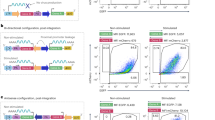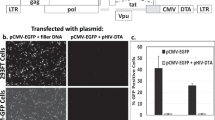Abstract
Suicide gene-therapy strategies are promising approaches in treating various diseases such as cancers, atherosclerosis, and graft-versus-host-disease. Here, we describe the development of a new effector gene based on inducing functional caspase 8, the initiator caspase in the death-receptor pathway. We constructed vectors encoding a constitutively active form of human caspase 8 (CC8), and demonstrated the efficient killing of a variety of cell types in transfection and lentivirus-transduction assays. We then analyzed the ability to control the apoptotic activity of a caspase 8-derived construct through the ARIAD™ homodimerization system (FKC8), a system shown to be extremely effective in several cellular models upon retroviral and lentiviral gene transfer. Similarly, two transcription-regulation systems, muristerone-regulated and Tet-On, were tested to control the expression of CC8. The homodimerization-regulated system FKC8 was shown to be the most efficient system with low background activity in noninduced conditions. In the presence of a dimerizer, it was as active as the activated Tet-On system. From our data, we conclude that the dimerizer-dependent human caspase 8 represents a highly inducible and very powerful system to eradicate transduced cell populations. In addition to its application in experimental gene therapy, this variant may be highly useful for mechanistic research related to apoptosis.
This is a preview of subscription content, access via your institution
Access options
Subscribe to this journal
Receive 12 print issues and online access
$259.00 per year
only $21.58 per issue
Buy this article
- Purchase on Springer Link
- Instant access to full article PDF
Prices may be subject to local taxes which are calculated during checkout





Similar content being viewed by others
References
van Dillen IJ, Mulder NH, Vaalburg W, et al. Influence of the bystander effect on HSV-tk/GCV gene therapy. A review. Curr Gene Ther. 2002;2:307–322.
Tomicic MT, Thust R, Kaina B . Ganciclovir-induced apoptosis in HSV-1 thymidine kinase expressing cells: critical role of DNA breaks, Bcl-2 decline and caspase-9 activation. Oncogene. 2002;21:2141–2153.
van der Eb MM, Geutskens SB, van Kuilenburg AB, et al. Ganciclovir nucleotides accumulate in mitochondria of rat liver cells expressing the herpes simplex virus thymidine kinase gene. J Gene Med. 2003;5:1018–1027.
Mullen CA, Anderson L, Woods K, et al. Ganciclovir chemoablation of herpes thymidine kinase suicide gene-modified tumors produces tumor necrosis and induces systemic immune responses. Hum Gene Ther. 1998;9:2019–2030.
Thomis DC, Marktel S, Bonini C, et al. A Fas-based suicide switch in human T cells for the treatment of graft-versus-host disease. Blood. 2001;97:1249–1257.
Fillat C, Carrio M, Cascante A, et al. Suicide gene therapy mediated by the Herpes Simplex virus thymidine kinase gene/Ganciclovir system: fifteen years of application. Curr Gene Ther. 2003;3:13–26.
Shariat SF, Desai S, Song W, et al. Adenovirus-mediated transfer of inducible caspases: a novel "death switch" gene therapeutic approach to prostate cancer. Cancer Res. 2001;61:2562–2571.
Martin DA, Siegel RM, Zheng L, et al. Membrane oligomerization and cleavage activates the caspase-8 (FLICE/MACHalpha1) death signal. J Biol Chem. 1998;273:4345–4349.
Clackson T . Controlling mammalian gene expression with small molecules. Curr Opin Chem Biol. 1997;1:210–218.
Spencer DM, Wandless TJ, Schreiber SL, et al. Controlling signal transduction with synthetic ligands. Science. 1993;262:1019–1024.
Spencer DM, Belshaw PJ, Chen L, et al. Functional analysis of Fas signaling in vivo using synthetic inducers of dimerization. Curr Biol. 1996;6:839–847.
MacCorkle RA, Freeman KW, Spencer DM . Synthetic activation of caspases: artificial death switches. Proc Natl Acad Sci USA. 1998;95:3655–3660.
Muzio M, Stockwell BR, Stennicke HR, et al. An induced proximity model for caspase-8 activation. J Biol Chem. 1998;273:2926–2930.
Yang X, Chang HY, Baltimore D . Autoproteolytic activation of pro-caspases by oligomerization. Mol Cell. 1998;1:319–325.
Clackson T, Yang W, Rozamus LW, et al. Redesigning an FKBP-ligand interface to generate chemical dimerizers with novel specificity. Proc Natl Acad Sci USA. 1998;95:10437–10442.
Gossen M, Freundlieb S, Bender G, et al. Transcriptional activation by tetracyclines in mammalian cells. Science. 1995;268:1766–1769.
No D, Yao TP, Evans RM . Ecdysone-inducible gene expression in mammalian cells and transgenic mice. Proc Natl Acad Sci USA. 1996;93:3346–3351.
Dull T, Zufferey R, Kelly M, et al. A third-generation lentivirus vector with a conditional packaging system. J Virol. 1998;72:8463–8471.
Zufferey R, Dull T, Mandel RJ, et al. Self-inactivating lentivirus vector for safe and efficient in vivo gene delivery. J Virol. 1998;72:9873–9880.
Miyoshi H, Blomer U, Takahashi M, et al. Development of a self-inactivating lentivirus vector. J Virol. 1998;72:8150–8157.
Barry SC, Harder B, Brzezinski M, et al. Lentivirus vectors encoding both central polypurine tract and posttranscriptional regulatory element provide enhanced transduction and transgene expression. Hum Gene Ther. 2001;12:1103–1108.
Carlotti F, Bazuine M, Kekarainen T, et al. Lentiviral vectors efficiently transduce quiescent mature 3T3-L1 adipocytes. Mol Ther. 2004;9:209–217.
Reiser J, Lai Z, Zhang XY, et al. Development of multigene and regulated lentivirus vectors. J Virol. 2000;74:10589–10599.
Brustugun OT, Fladmark KE, Doskeland SO, et al. Apoptosis induced by microinjection of cytochrome c is caspase-dependent and is inhibited by Bcl-2. Cell Death Differ. 1998;5:660–668.
Larregina AT, Morelli AE, Dewey RA, et al. FasL induces Fas/Apo1-mediated apoptosis in human embryonic kidney 293 cells routinely used to generate E1-deleted adenoviral vectors. Gene Ther. 1998;5:563–568.
Kim AH, Khursigara G, Sun X, et al. Akt phosphorylates and negatively regulates apoptosis signal-regulating kinase 1. Mol Cell Biol. 2001;21:893–901.
Slee EA, Zhu H, Chow SC, et al. Benzyloxycarbonyl-Val-Ala-Asp (OMe) fluoromethylketone (Z-VAD.FMK) inhibits apoptosis by blocking the processing of CPP32. Biochem J. 1996;315 (Pt 1):21–24.
Fujioka S, Schmidt C, Sclabas GM, et al. Stabilization of p53 is a novel mechanism for proapoptotic function of NF-kappaB. J Biol Chem. 2004;279:27549–27559.
Stamminger T, Fleckenstein B . Immediate-early transcription regulation of human cytomegalovirus. Curr Top Microbiol Immunol. 1990;154:3–19.
Barcia RN, Valle NS, McLeod JD . Caspase involvement in RIP-associated CD95-induced T cell apoptosis. Cell Immunol. 2003;226:78–85.
Whitacre CM, Satoh TH, Xue L, et al. Photodynamic therapy of human breast cancer xenografts lacking caspase-3. Cancer Lett. 2002;179:43–49.
Lazebnik YA, Kaufmann SH, Desnoyers S, et al. Cleavage of poly(ADP-ribose) polymerase by a proteinase with properties like ICE. Nature. 1994;371:346–347.
Ashkenazi A, Dixit VM . Death receptors: signaling and modulation. Science. 1998;281:1305–1308.
Grutter MG . Caspases: key players in programmed cell death. Curr Opin Struct Biol. 2000;10:649–655.
Salvesen GS, Dixit VM . Caspase activation: the induced-proximity model. Proc Natl Acad Sci USA. 1999;96:10964–10967.
Ray CA, Black RA, Kronheim SR, et al. Viral inhibition of inflammation: cowpox virus encodes an inhibitor of the interleukin-1 beta converting enzyme. Cell. 1992;69:597–604.
Bump NJ, Hackett M, Hugunin M, et al. Inhibition of ICE family proteases by baculovirus antiapoptotic protein p35. Science. 1995;269:1885–1888.
Xu G, Cirilli M, Huang Y, et al. Covalent inhibition revealed by the crystal structure of the caspase-8/p35 complex. Nature. 2001;410:494–497.
Irmler M, Thome M, Hahne M, et al. Inhibition of death receptor signals by cellular FLIP. Nature. 1997;388:190–195.
Tschopp J, Irmler M, Thome M . Inhibition of fas death signals by FLIPs. Curr Opin Immunol. 1998;10:552–558.
Chang DW, Xing Z, Pan Y, et al. c-FLIP(L) is a dual function regulator for caspase-8 activation and CD95-mediated apoptosis. EMBO J. 2002;21:3704–3714.
Micheau O, Thome M, Schneider P, et al. The long form of FLIP is an activator of caspase-8 at the Fas death-inducing signaling complex. J Biol Chem. 2002;277:45162–45171.
Deveraux QL, Reed JC . IAP family proteins—suppressors of apoptosis. Genes Dev. 1999;13:239–252.
Deveraux QL, Takahashi R, Salvesen GS, et al. X-linked IAP is a direct inhibitor of cell-death proteases. Nature. 1997;388:300–304.
Yang L, Cao Z, Yan H, et al. Coexistence of high levels of apoptotic signaling and inhibitor of apoptosis proteins in human tumor cells: implication for cancer specific therapy. Cancer Res. 2003;63:6815–6824.
Freundlieb S, Schirra-Muller C, Bujard H . A tetracycline controlled activation/repression system with increased potential for gene transfer into mammalian cells. J Gene Med. 1999;1:4–12.
Lamartina S, Roscilli G, Rinaudo CD, et al. Stringent control of gene expression in vivo by using novel doxycycline-dependent trans-activators. Hum Gene Ther. 2002;13:199–210.
Urlinger S, Baron U, Thellmann M, et al. Exploring the sequence space for tetracycline-dependent transcriptional activators: novel mutations yield expanded range and sensitivity. Proc Natl Acad Sci USA. 2000;97:7963–7968.
Latta-Mahieu M, Rolland M, Caillet C, et al. Gene transfer of a chimeric trans-activator is immunogenic and results in short-lived transgene expression. Hum Gene Ther. 2002;13:1611–1620.
Xie X, Zhao X, Liu Y, et al. Adenovirus-mediated tissue-targeted expression of a caspase-9-based artificial death switch for the treatment of prostate cancer. Cancer Res. 2001;61:6795–6804.
Boatright KM, Renatus M, Scott FL, et al. A unified model for apical caspase activation. Mol Cell. 2003;11:529–541.
Chang DW, Xing Z, Capacio VL, et al. Interdimer processing mechanism of procaspase-8 activation. EMBO J. 2003;22:4132–4142.
Wencker D, Chandra M, Nguyen K, et al. A mechanistic role for cardiac myocyte apoptosis in heart failure. J Clin Invest. 2003;111:1497–1504.
Mallet VO, Mitchell C, Guidotti JE, et al. Conditional cell ablation by tight control of caspase-3 dimerization in transgenic mice. Nat Biotechnol. 2002;20:1234–1239.
Acknowledgements
FC was supported by a fellowship from the MENRT (Ministère Français de l’Education Nationale, de la Recherche et de la Technologie), and a fellowship from Eurogendis. We are thankful to J Galipeau, MJ Lenardo, M Piechaczyk, V Dixit, JC Chambard, H Bujard, P Friesen, and ARIAD for sharing with us several constructs and reagents used in this study. In addition, we gratefully acknowledge Martijn Rabelink for helpful technical assistance.
Author information
Authors and Affiliations
Corresponding author
Rights and permissions
About this article
Cite this article
Carlotti, F., Zaldumbide, A., Martin, P. et al. Development of an inducible suicide gene system based on human caspase 8. Cancer Gene Ther 12, 627–639 (2005). https://doi.org/10.1038/sj.cgt.7700825
Received:
Published:
Issue Date:
DOI: https://doi.org/10.1038/sj.cgt.7700825
Keywords
This article is cited by
-
Induction of rapid and selective cell necrosis in Drosophila using Bacillus thuringiensis Cry toxin and its silkworm receptor
BMC Biology (2015)
-
miR-34c may protect lung cancer cells from paclitaxel-induced apoptosis
Oncogene (2013)
-
A caspase 8-based suicide switch induces apoptosis in nanobody-directed chimeric receptor expressing T cells
International Journal of Hematology (2012)
-
A suicide gene approach using the human pro-apoptotic protein tBid inhibits HIV-1 replication
BMC Biotechnology (2011)
-
How not to be seen: immune-evasion strategies in gene therapy
Gene Therapy (2008)



